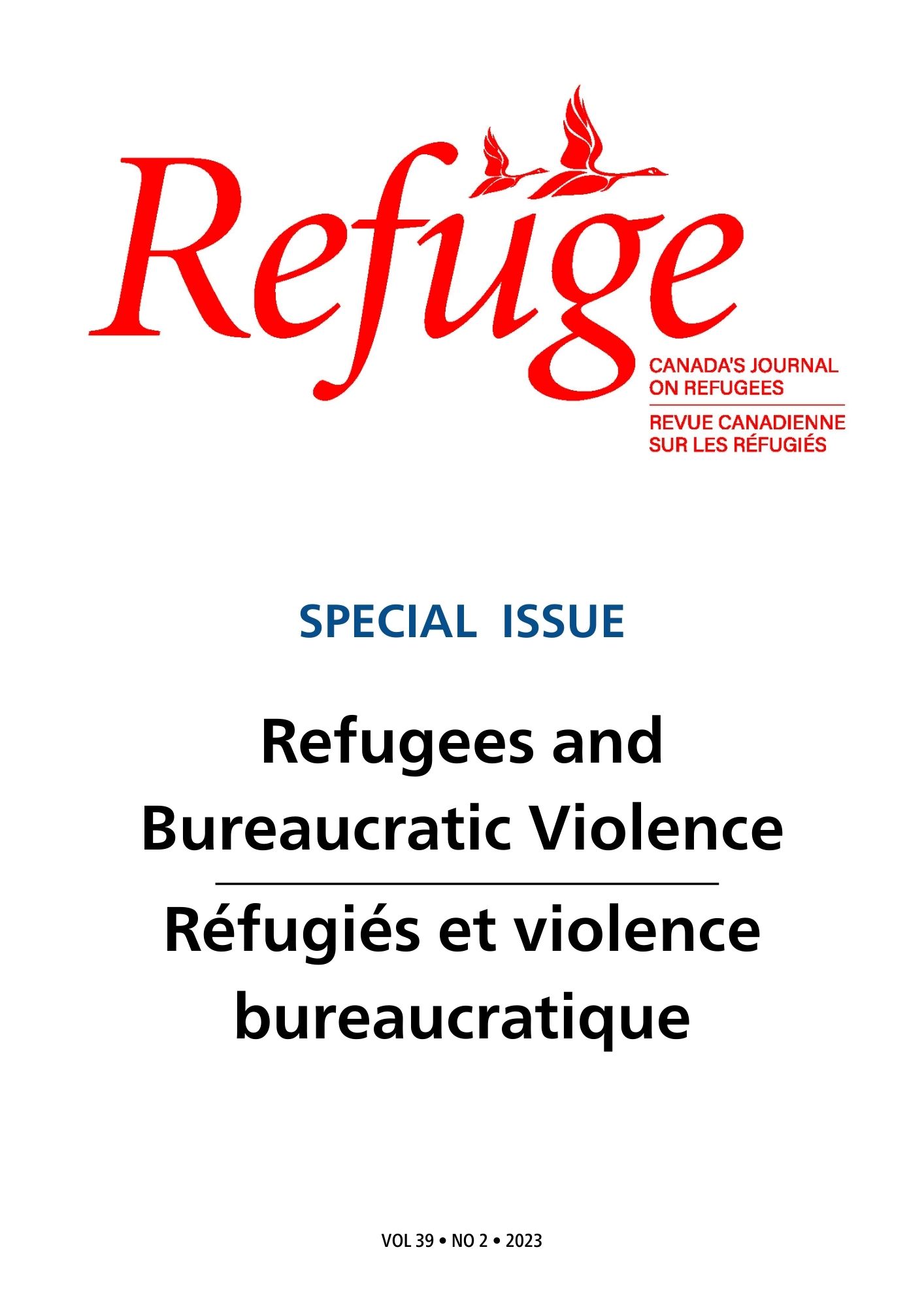Perceived Discrimination and Poverty among Syrian Refugee Women in Jordan
DOI:
https://doi.org/10.25071/1920-7336.41107Keywords:
Discrimination, Poverty, Syria, Jordan, Refugees, WomenAbstract
The Syrian Civil War displaced millions of Syrian women and children, many of whom face economic challenges and discrimination. This paper examines self-reported poverty and its relationship with perceived discrimination among women, as framed by social exclusion theory. The cross-sectional study included 507 Syrian refugee women visiting health clinics outside camps in Jordan. Consistent with our hypothesis, 79.09% of women reported poverty as a serious problem, and women reporting discrimination were found to have higher odds of reporting poverty as a serious problem post-migration (AOR: 3.489; 95% CI: 1.534, 7.937). Gender-responsive interventions, policy implications, and recommendations are addressed.
Metrics
References
Agudelo-Suárez, A. A., Ronda-Pérez, E., Gil-González, D., Vives-Cases, C., García, A. M., Ruiz-Frutos, C., Felt, E., & Benavides, F. G. (2011). The effect of perceived discrimination on the health of immigrant workers in Spain. BMC Public Health, 11(652), 1–9. https://doi.org/10.1186/1471-2458-11-652
Alrababa’h, A., Dillon, A., Williamson, S., Hainmueller, J., Hangartner, D., & Weinstein, J. (2021). Attitudes toward migrants in a highly impacted economy: Evidence from the Syrian refugee crisis in Jordan. Comparative Political Studies, 54(1), 33–76. https://doi.org/10.1177/0010414020919910
Ay, M., González, P. A., & Delgado, R. C. (2016). The perceived barriers of access to health care among a group of non-camp Syrian refugees in Jordan. International Journal of Health Services, 46(3), 566–589. https://doi.org/10.1177/0020731416636831
Aygül, H. H., & Kaba, E. M. (2019). The participation and experience of Syrian women in labour force (the case of Sultanbeyli, Istanbul). Turkish Studies—Social Sciences, 14(4), 1255–1275. https://doi.org/10.29228/TurkishStudies.23013
Berman, Y., & Phillips, D. (2000). Indicators of social quality and social exclusion at national and community level. Social Indicators Research, 50, 329–350. https://www.jstor.org/stable/27522464
Brooks, M. A., Meinhart, M., Samawi, L., Mukherjee, T., Jaber, R., Alhomsh, H., Kaushal, N., Al Qutob, R., Khadra, M., El-Bassel, N., & Dasgupta, A. (2022). Mental health of clinic-attending Syrian refugee women in Jordan: Associations between social ecological risks factors and mental health symptoms. BMC Women’s Health, 22(4), 1–17. https://doi.org/10.1186/s12905-021-01584-y
Brown, H., Giordano, N., Maughan, C., & Wadeson, A. (2019). Vulnerability assessment framework: Population study 2019. UNHCR. https://www.unhcr.org/us/media/38835
Buscher, D. (2011). New approaches to urban refugee livelihoods. Refuge: Canada’s Journal on Refugees, 28(2), 17–29. https://doi.org/10.25071/1920-7336.36473
Carrion, D. (2015, September). Syrian refugees in Jordan: Confronting difficult truths [Research paper]. Chatham House. https://www.chathamhouse.org/sites/default/files/publications/research/20150921SyrianRefugeesCarrion.pdf
Casagrande, S. S., Gary, T. L., LaVeist, T. A., Gaskin, D. J., & Cooper, L. A. (2007). Perceived discrimination and adherence to medical care in a racially integrated community. Journal of General Internal Medicine, 22(3), 389–395. https://doi.org/10.1007/s11606-006-0057-4
Dahi, O. (2014). The refugee crisis in Lebanon and Jordan: The need for economic development spending. Forced Migration Review, 47, 11–13. https://www.fmreview.org/syria/dahi
DeCormier Plosky, W. (2017). An investment case for addressing social drivers of structural stigma and discrimination against refugees in resource-poor urban areas [Doctoral dissertation, Columbia University]. Columbia University ProQuest Dissertations Publishing. https://www.proquest.com/dissertations-theses/investment-case-addressing-social-drivers/docview/1964898893/se-2
European Commission. (2022).Jordan. European Civil Protection and Humanitarian Aid Operations. https://ec.europa.eu/echo/where/middle-east/jordan_en
Fallah, B., Krafft, C., & Wahba, J. (2019). The impact of refugees on employment and wages in Jordan. Journal of Development Economics, 139, 203–216. https://doi.org/10.1016/j.jdeveco.2019.03.009
Folstein, M. F., Folstein, S. E., McHugh, P. R. (1975). “Mini-mental state”: A practical method for grading the cognitive state of patients for the clinician. Journal of Psychiatric Research, 12(3), 189–98. https://doi.org/10.1016/0022-3956(75)90026-6
Fredman, S. (2007). Redistribution and recognition: Reconciling inequalities. South African Journal on Human Rights, 23(2), 214–234. https://doi.org/10.1080/19962126.2007.11864923
Gage, A. J., & Thomas, N. J. (2017). Women’s work, gender roles, and intimate partner violence in Nigeria. Archives of Sexual Behavior, 46, 1923–1938. https://doi.org/10.1007/s10508-017-1023-4
Ganty, S. (2021). Poverty as misrecognition: What role for antidiscrimination law in Europe? Human Rights Law Review, 21, 962–1007. https://doi.org/10.1093/hrlr/ngab016
Goodkind, J. R., Hess, J. M., Isakson, B., LaNoue, M., Githinji, A., Roche, N., Vadnais, K., & Parker, D. P. (2014). Reducing refugee mental health disparities: A community-based intervention to address post-migration stressors with African adults. Psychological Services, 11(3), 333–346. https://doi.org/10.1037/a0035081
Hagen-Zanker, J., Ulrichs, M., & Holmes, R. (2018). What are the effects of cash transfers for refugees in the context of protracted displacement? Findings from Jordan. International Social Security Review, 71, 57–77. https://doi.org/10.1111/issr.12166
Hanafi, S., Chaaban, J., & Seyfert, K. (2012). Social exclusion of Palestinian refugees in Lebanon: Reflections on the mechanisms that cement their persistent poverty. Refugee Survey Quarterly, 31(1), 34–53. https://doi.org/10.1093/rsq/hdr018
Hollifield, M., Warner, T., Lian, N., Krakow, B., Jenkins, J. H., Kesler, J., Stevenson, J., & Westermeyer, J. (2011). Assessments for trauma and mental health in refugees. Refugee Health Technical Assistance Center. https://refugeehealthta.org/physical-mental-health/mental-health/adult-mental-health/assessments-for-trauma-and-mental-health-in-refugees/ (Adapted from “Measuring trauma and health status in refugees: A critical review,” 2002, JAMA: Journal of the American Medical Association, 288[5], 611–621. https://doi.org/10.1001/jama.288.5.611)
Hynie, M. (2008). The social determinants of refugee mental health in the post-migration context: A critical review. The Canadian Journal of Psychiatry, 63(5), 297–303. https://doi.org/10.1177/0706743717746666
Jasinskaja-Lahti, I., Liebkind, K., & Perhoniemi, R. (2006). Perceived discrimination and well-being: A victim study of different immigrant groups. Journal of Community & Applied Social Psychology, 16, 267–284. https://doi.org/10.1002/casp.865
Krieger, N. (2014). Discrimination and health inequities. International Journal of Health Services, 44(4), 643–710. https://doi.org/10.2190/HS.44.4.b
Kuivalainen, S. (2014). Subjective poverty. In A. C. Michalos (Ed.), Encyclopedia of quality of life and well-being research (pp. 6432–6434). Springer. https://doi.org/10.1007/978-94-007-0753-5_2900
Lukasiewicz, K. (2017). Exile to poverty: Policies and poverty among refugees in Poland. International Migration, 55(6), 56–72. https://doi.org/10.1111/imig.12356
Mathieson, J., Popay, J., Enoch, E., Escorel, S., Hernandez, M., Johnston, H., & Rispel, L. (2008). Social exclusion: Meaning, measurement and experience and links to health inequalities: A review of the literature (WHO Social Exclusion Knowledge Network Background Paper I). World Heath Organization. https://www.who.int/social_determinants/media/sekn_meaning_measurement_experience_2008.pdf.pdf
Memişoğlu, F., & Yavçan, B. (2020). Beyond ideology—A comparative analysis of how local governance can expand national integration policy: The case of Syrian refugees in Istanbul. Journal of Ethnic and Migration Studies, 48(3), 503–523. https://doi.org/10.1080/1369183X.2020.1819780
Norwegian Refugee Council. (2015, June). In search of a home: Access to adequate housing in Jordan. https://www.nrc.no/globalassets/pdf/reports/in-search-of-a-home.pdf
Pascoe, E. A., & Richman, L. S. (2009). Perceived discrimination and health: A meta-analytic review. Psychological Bulletin, 135(4), 531–544. https://doi.org/10.1037/a0016059
REACH. (2014, June). Perceptions of external support in Jordanian communities hosting Syrian refugees: Thematic assessment report. British Embassy Amman. https://reliefweb.int/sites/reliefweb.int/files/resources/REACH_JOR_Report_PerceptionsofExternalSupportinJordanianCommunitiesHostingSyrianRefugees.pdf
Ritchie, H. A. (2018). Gender and enterprise in fragile refugee settings: Female empowerment amidst male emasculation—A challenge to local integration? Disasters, 42(S1), S40–S60. https://doi.org/10.1111/disa.12271
Savadogo, G., Souarès, A., Sié, A., Parmar, D., Bibeau, G., & Sauerborn, R. (2015). Using a community-based definition of poverty for targeting poor households for premium subsidies in the context of a community health insurance in Burkina Faso. BMC Public Health, 15(84), Article 84. https://doi.org/10.1186/s12889-014-1335-4
Schick, M., Morina, N., Mistridis, P., Schnyder, U., Bryant, R. A., & Nickerson, A. (2018). Changes in post-migration living difficulties predict treatment outcome in traumatized refugees. Frontiers in Psychiatry, 9(476), Article 476. https://doi.org/10.3389/fpsyt.2018.00476
Shanneik, Y. (2021). Displacement, humanitarian interventions and gender rights in the Middle East: Syrian refugees in Jordan as a case study. Journal of Ethnic and Migration Studies, 47(15), 3329–3344. https://doi.org/10.1080/1369183X.2021.1926944
Silove, D., Sinnerbrink, I., Field, A., Manicavasagar, V., & Steel, Z. (1997). Anxiety, depression and PTSD in asylum-seekers: Associations with pre-migration trauma and post-migration stressors. The British Journal of Psychiatry, 170, 351–357. https://doi.org/10.1192/bjp.170.4.351
Silove, D., Steel, Z., McGorry, P., & Mohan, P. (1998). Trauma exposure, postmigration stressors, and symptoms of anxiety, depression and post-traumatic stress in Tamil asylum-seekers: Comparison with refugees and immigrants. Acta Psychiatrica Scandinavica, 97(3), 175–181. https://doi.org/10.1111/j.1600-0447.1998.tb09984.x
Singh, A., El-Bassel, N., Kaushal, N., Meinhart, M., Hartmann, J. K., Mukherjee, T., Khadra, M., Jaber, R., Al-Qutob, R., & Dasgupta, A. (2022). Financial dependence and intimate partner violence (IPV) among married Syrian refugee women living in non-camp settings in Jordan. Journal of Global Health Reports, 6, Article e2022011. https://doi.org/10.29392/001c.33049
Spiegel, P., Checci, F., Colombo, S., & Paik, E. (2010). Health-care needs of people affected by conflict: Future trends and changing networks. Lancet, 375, 341–345. https://doi.org/10.1016/S0140-6736(09)61873-0
Stave, S. E., & Hillesund, S. (2015). Impact of Syrian refugees on the Jordanian labour market: Findings from the governorates of Amman, Irbid and Mafraq. International Labour Organization Regional Office for the Arab States and Fafo. https://www.fafo.no/images/pub/2015/20421.pdf
Steel, Z., Silove, D., Bird, K., McGorry, P., & Mohan, P. (1999). Pathways from war trauma to posttraumatic stress symptoms among Tamil asylum seekers, refugees, and immigrants. Journal of Traumatic Stress, 12(3), 421–435. https://doi.org/10.1023/a:1024710902534
Szaflarski, M., & Bauldry, S. (2019). The effects of perceived discrimination on immigrant and refugee physical and mental health. Advances in Medical Sociology, 19, 173–204. https://doi.org/10.1108/S1057-629020190000019009
UNHCR. (2019). Regional strategic overview: 2019/2020. https://data2.unhcr.org/en/documents/download/67370
UNHCR. (2021, June 18). Global trends: Forced displacement in 2019. https://www.unhcr.org/flagship-reports/globaltrends/globaltrends2019/
UNHCR. (2022). Regional needs overview: 2022. https://www.3rpsyriacrisis.org/wp-content/uploads/2022/03/Regional_Needs_Overview_2021.pdf
United Nations Office for the Coordination of Humanitarian Affairs (OCHA). (2018, December 4). Global humanitarian overview 2019. https://www.unocha.org/sites/unocha/files/GHO2019.pdf
Verme, P., Gigliarano, C., Wieser, C., Hedlund, K., Petzoldt, M., & Santacroce, M. (2016). The welfare of Syrian refugees: Evidence from Jordan and Lebanon. World Bank. http://hdl.handle.net/10986/23228
World Bank. (2014). Jordan economic monitor: Resilience amid turmoil. https://www.worldbank.org/content/dam/Worldbank/document/MNA/JEM-Spring-2014.pdf
Downloads
Published
How to Cite
Issue
Section
License
Copyright (c) 2023 Jennifer M.K. Hartmann, Trena I. Mukherjee, Maysa Khadra, Neeraj Kaushal, Nabila El-Bassel, Anindita Dasgupta

This work is licensed under a Creative Commons Attribution-NonCommercial 4.0 International License.
Refuge authors retain the copyright over their work, and license it to the general public under the Creative Commons Attribution-Non Commercial License International (CC BY-NC 4.0). This license allows for non-commercial use, reproduction and adaption of the material in any medium or format, with proper attribution. For general information on Creative Commons licences, visit the Creative Commons site. For the CC BY-NC 4.0 license, review the human readable summary.







